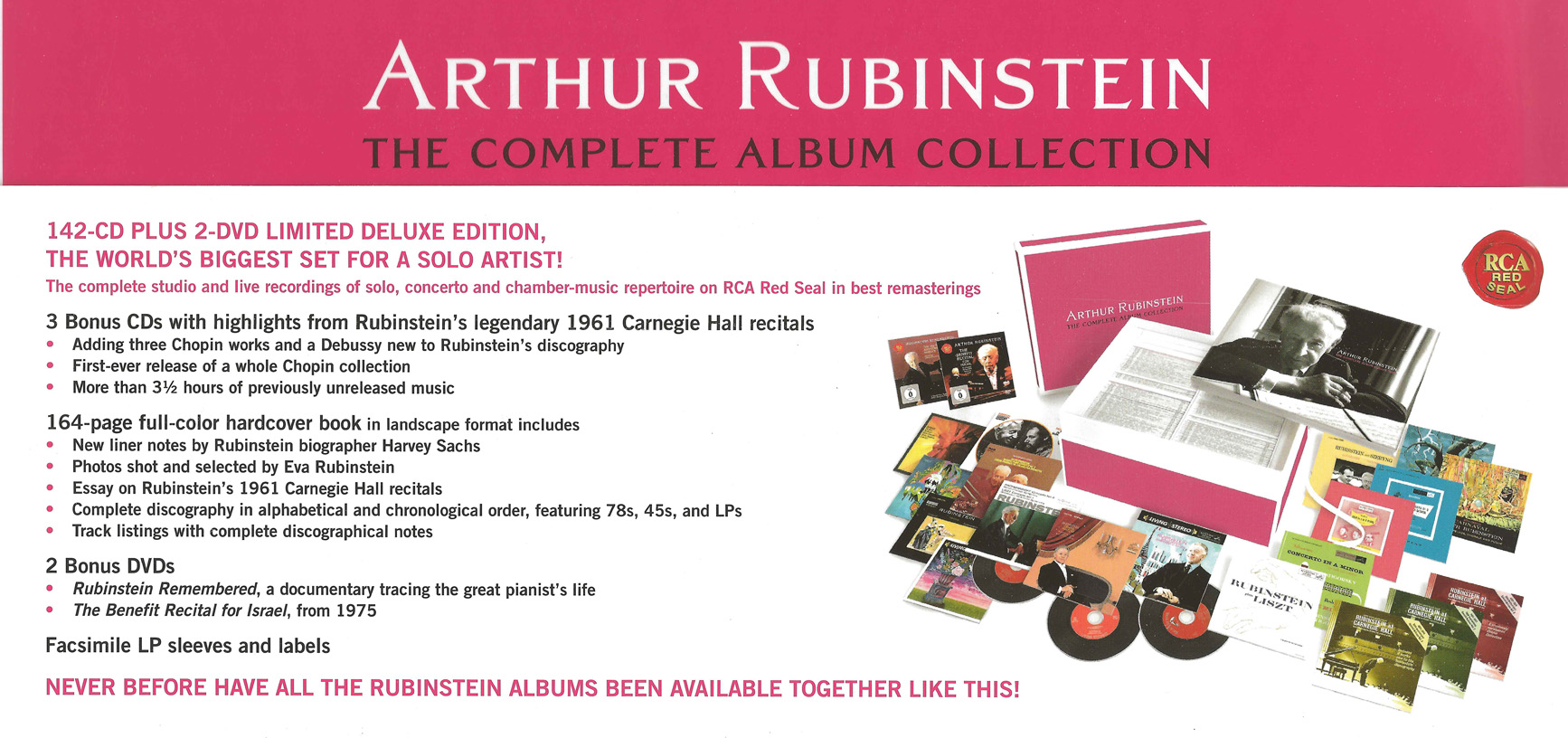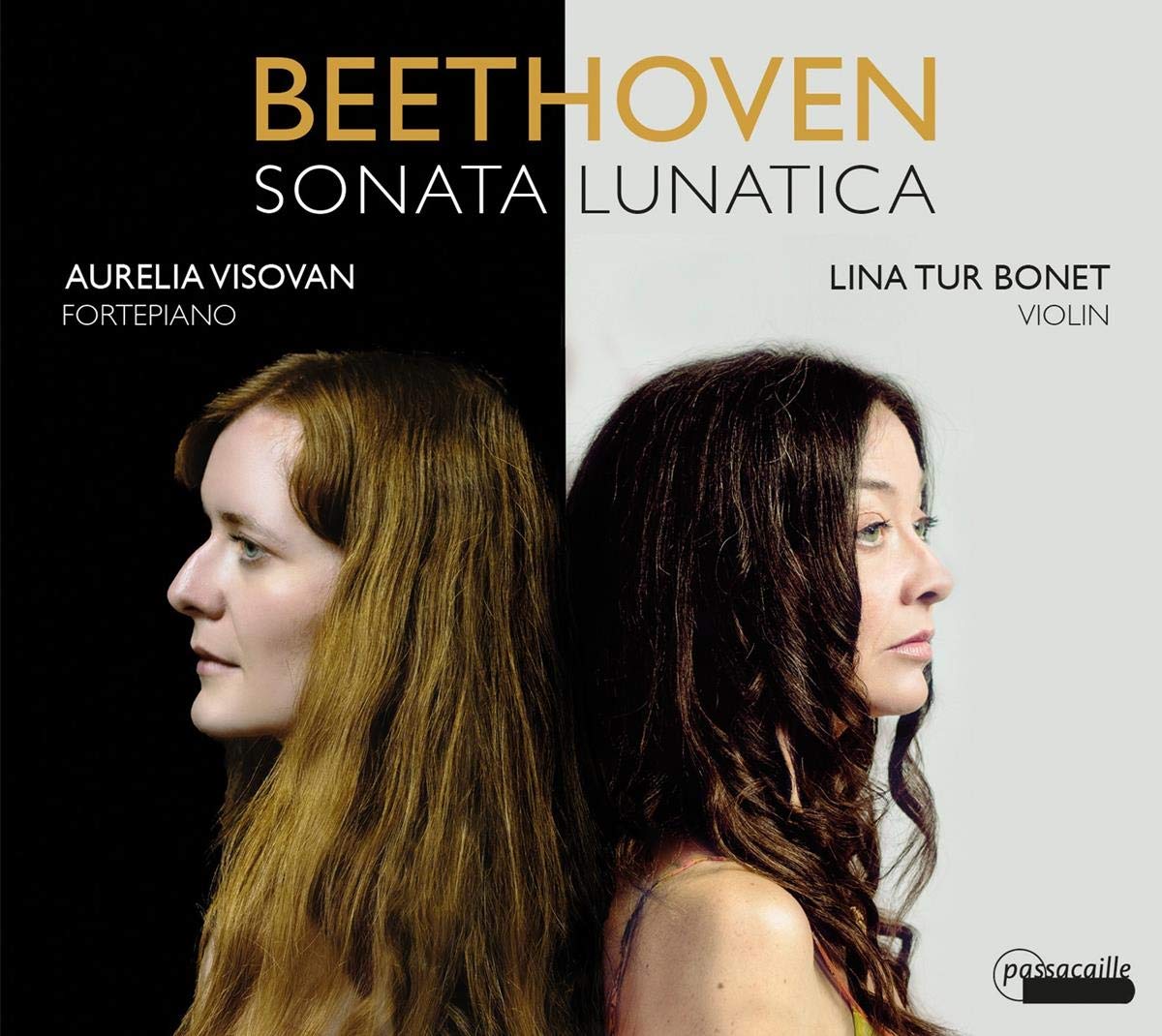Ludwig van Beethoven
Sonata for Piano and Violin No.9 in A major, op.47, “Kreutzer”
Media Review / Comparison
2012-01-09 — Original posting (on Blogger)
2012-03-02 — Updates
2013-07-15 — New standard layout applied
2014-05-10 — Added reference to CD from Rubinstein Album Collection
2014-11-01 — Re-posting as is (WordPress)
2016-06-23 — Brushed up for better readability
2021-04-25 — Added comparison table and recording with Lina Tur Bonet & Aurelia Vişovan
Table of Contents
- Introduction
- Violin Sonata No.9 in A major, op.47, “Kreutzer” — The Movements
- Comments on the Interpretations
- Yehudi Menuhin, Wilhelm Kempff (1970)
- Henryk Szeryng, Arthur Rubinstein (1961)
- David Oistrakh, Lev Oborin (1962)
- Arthur Grumiaux, Clara Haskil (1957)
- Itzhak Perlman, Vladimir Ashkenazy (1975)
- Adolf Busch, Rudolf Serkin (1941)
- Itzhak Perlman, Martha Argerich (1998)
- Renaud Capuçon, Frank Braley (2009)
- Gidon Kremer, Martha Argerich (1995)
- Viktoria Mullova, Kristian Bezuidenhout (2010)
- Isabelle Faust, Alexander Melnikov (2008)
- Lina Tur Bonet, Aurelia Vişovan (2020)
- Comparison Table
Introduction
This is another note on the recordings of Beethoven’s sonatas for piano & violin in my music collection, about the Sonata in A major, op.47, “Kreutzer Sonata” — references to the CDs are given at the bottom of the respective section, or in one of the related postings, or see the summary on the postings covering Beethoven’s Sonatas for Piano & Violin.
Below you find my comments on the recordings that I have for the Sonata for Piano and Violin No.9 in A major, op.47, “Kreutzer Sonata”, by Ludwig van Beethoven (1770 – 1827). Here’s a short list of the recordings in this comparison, in alphabetic order:
- Adolf Busch & Rudolf Serkin (1941)
- Renaud Capuçon & Frank Braley (2009)
- Isabelle Faust & Alexander Melnikov (2008)
- Arthur Grumiaux & Clara Haskil (1957)
- Gidon Kremer & Martha Argerich (1995)
- Yehudi Menuhin & Wilhelm Kempff (1970)
- Viktoria Mullova & Kristian Bezuidenhout (2009)
- David Oistrakh & Lev Oborin (1962)
- Itzhak Perlman & Martha Argerich (1998)
- Itzhak Perlman & Vladimir Ashkenazy (1973)
- Henryk Szeryng & Arthur Rubinstein (1958)
- Lina Tur Bonet & Aurelia Vişovan (2020)
Violin Sonata No.9 in A major, op.47, “Kreutzer” — The Movements
The movements in this sonata are
- Adagio sostenuto (3/4) — Presto (alla breve, 2/2)
- Andante con Variazioni (2/4): Andante — Var. I — Var. II — Var. III (minore) — Var. IV (maggiore)
- Finale: Presto (6/8)
Tempo Issues
Interesting: it appears that mostly the slow movements are the ones having “tempo issues”! Here, (romantic?) tradition demands that the middle movement in op.47 be played slowly, totally ignoring the 2/4 notation (i.e., playing an andante in 4/8 measures) — but why then would Beethoven write “2/4” in first place, and why would he repeat that notation at the beginning of every single variation?
In that same middle movement in op.47, the last variation contains a few additional stumbling blocks: bar 57 contains a fermata, followed by a short cadenza for the piano, molto adagio, but bar 59 is back to “Tempo I” (dolce in the violin part). Bar 61 contains a joined cadenza and several fermatas, so presumably the artists are given a fair amount of freedom for this bar. Most (traditional) interpretations simply prolong the molto adagio up to bar 61 (OK, some play that movement so slow that the molto adagio is hardly recognized as being distinctly different from the rest of the movement).
The Art of Accelerating
The prolonged Adagio then leads into the next trap: bars 62 – 67 consist of (mostly) a prolonged trill on the violin, accompanied by repetitive triple figures on the piano. A layman pianist may feel compelled to accelerate over these repetitive figures — however, this bears the danger of sounding like an accelerating steam locomotive. I remember Leonard Bernstein once using that analog in a conducting master class in the Schleswig-Holstein Music Festival (which I watched on TV): one of the pupils was conducting a romantic orchestral piece with such an accelerando, which Bernstein claimed to sound totally ridiculous.
He then conducted the same piece himself, starting with the same tempo, and ending with the same, faster tempo — however, everybody was baffled by the fact that Bernstein’s accelerando was not perceived as such! My conclusion for bars 62 – 67 in this andante: one should either avoid accelerando altogether (the harmonic progression in these bars already creates an impression of acceleration), or, as practiced by Alexander Melnikov, do it rapidly over 1 – 2 bars, avoiding any impression of “accelerating machinery”.
The (measured) metronome numbers are approximate values only.
Comments on the Interpretations
Yehudi Menuhin, Wilhelm Kempff (1970)
Beethoven, The Complete Violin Sonatas, Vol.II: Sonatas op.30, op.47, op.96
Yehudi Menuhin, Wilhelm Kempff
DG 459 436-2 (stereo, 2 CD); ℗ 1970

Yehudi Menuhin and Wilhelm Kempff (1970) — for general comments see op.30/1
Comments on the Performance
I. Adagio sostenuto (3/4) — Presto (alla breve, 2/2)
Duration: 14’53”; 1/4 = 40 — 1/2 = 132 (Presto)
The tempo in the introduction is OK, but the main part is not presto, i.e., should be faster. That part is also rather stiff, and the constant f or ff over long stretches is somewhat tiring, on top of that, the vibrato is rather nervous. Finally, the extreme rallentando (leading to the fermata) at the end of the exposition is very heavy and unnecessary.
II. Andante con Variazioni (2/4): Andante — Var. I — Var. II — Var. III (minore) — Var. IV (maggiore)
Duration: 16’07”; 1/4 = 43 (Theme)
Theme and variation I are very static and to me felt somewhat superficial, and the slow acciaccaturas feel a bit odd. Variation II has some intonation issues and extra portamenti. Overall, there is a lot of (too much) legato in the violin part.
III. Finale: Presto (6/8)
Duration: 9’57”; 3/8 = 160
Not presto, rather an Allegretto. The performance lacks tension, drive, and has some coordination issues. Are the artists tired at the end, or is it tiring to listen to this interpretation?
| Recommendation: | No |
| Rating: | 1.7 (1 / 2 / 2) |
Henryk Szeryng, Arthur Rubinstein (1961)
Beethoven: Violin Sonatas Nos. 5, 8, 9 (op.24, op.30/3, op.47)
Henryk Szeryng, Arthur Rubinstein (1961)
RCA Victor / BMG 09026 63040-2 (stereo); ℗ / © 2003

Arthur Rubinstein — The Complete Album Collection
CD #70: Beethoven: Kreutzer & Spring Sonatas (op.47, op.24)
Arthur Rubinstein, Henryk Szeryng (1961)
SONY Classical 88691936912 (142 CDs / 2 DVDs, mono / stereo); ℗ / © 2011
Documentation 162 pp., track listing on CD sleeve

Arthur Rubinstein and Henryk Szeryng (1961) — for general comments see op.24
Comments on the Performance
I. Adagio sostenuto (3/4) — Presto (alla breve, 2/2)
Duration: 10’50” (exposition not repeated); 1/4 = 42 — 1/2 = 150 (Presto)
A good tempo in the introduction, but the movement sounds like old-fashioned intonation / articulation (somewhat coarse), there are rushed passages in the piano part.
II. Andante con Variazioni (2/4): Andante — Var. I — Var. II — Var. III (minore) — Var. IV (maggiore)
Duration: 15’07”; 1/4 = 45 (Theme)
I dislike Szeryng’s vibrato, especially if combined with extra, unnecessary portamenti. Variation I is rather stiff, “leggy”, rather than witty.
III. Finale: Presto (6/8)
Duration: 6’39” (no repetition); 3/8 = 190
Rushed / superficial / inaccurate passages, occasionally bad tempo control.
| Recommendation: | No |
| Rating: | 2.3 (3 / 2 / 2) |
David Oistrakh, Lev Oborin (1962)
Beethoven: The Violin Sonatas (op.12, op.23, op.24, op.30, op.47, op.96)
Philips 468 406-2 (stereo, 4 CD); ℗ 2001

David Oistrakh and Lev Oborin (1962) — for CD information and general comments see op.12/1
Comments on the Performance
I. Adagio sostenuto (3/4) — Presto (alla breve, 2/2)
Duration: 11’43” (exposition not repeated); 1/4 = 33 — 1/2 = 136 (Presto)
The introduction is too slow, and the Presto is stiff / not flexible, static — and not presto, i.e., also too slow.
II. Andante con Variazioni (2/4): Andante — Var. I — Var. II — Var. III (minore) — Var. IV (maggiore)
Duration: 15’26”; 1/4 = 42 (Theme)
Slow as most other traditional interpretations (4/8 rather than 2/4). While the recording fails to show much of Oistrakh’s qualities, I think it’s one of Lev Oborin’s best, most subtle performances in this series.
III. Finale: Presto (6/8)
Duration: 7’08” (no repetition); 3/8 = 170
Not presto, maybe an Allegro. In details OK, but static overall, lacks vitality, drama, emotions.
| Recommendation: | No |
| Rating: | 2.7 (2 / 3 / 3) |
Arthur Grumiaux, Clara Haskil (1957)
Beethoven: The Violin Sonatas (op.12, op.23, op.24, op.30, op.47, op.96)
Brilliant Classics 93329 (mono, 3 CD); licensed from Decca

Arthur Grumiaux and Clara Haskil (1957) — for CD information and general comments see op.12/1
Comments on the Performance
I. Adagio sostenuto (3/4) — Presto (alla breve, 2/2)
Duration: 10’57” (exposition not repeated); 1/4 = 48 — 1/2 = 152 (Presto)
The fastest introduction among the interpretations here — I don’t quite feel at ease with this: maybe it’s a tad too fast, missing the calm (adagio) character? In the Presto part, the piano often sounds like played with excess pedal, lacking clarity, transparency — this may in parts or entirely be caused by the strong reverberation (bath room acoustics) and/or by limitations in the recording technique. There are some coordination issues, and over long stretches I get the impression that both instruments are played loud, like trying to beat each other.
II. Andante con Variazioni (2/4): Andante — Var. I — Var. II — Var. III (minore) — Var. IV (maggiore)
Duration: 16’10”; 1/4 = 38 (Theme)
Very slow, played as 4/8 rather than 2/4 (variation III is in 2/4, but lento), the sforzati could be more pronounced, especially at the beginning.
III. Finale: Presto (6/8)
Duration: 6’46” (no repetition); 3/8 = 180
Has drive and vitality — but the bathroom acoustics turn the piano into a muddy sound soup, making it hard, if not impossible to judge / appreciate Clara Haskil’s playing.
| Recommendation: | Not really |
| Rating: | 3.0 (3 / 3 / 3) |
Itzhak Perlman, Vladimir Ashkenazy (1975)
Beethoven: The Violin Sonatas (op.12, op.23, op.24, op.30, op.47, op.96)
Itzhak Perlman, Vladimir Ashkenazy
Decca 421 453-2 (stereo, 4 CD); ℗ 1974 / © 1988

Itzhak Perlman and Vladimir Ashkenazy (1975) — for CD information and general comments see op.12/1
Comments on the Performance
I. Adagio sostenuto (3/4) — Presto (alla breve, 2/2)
Duration: 11’52” (exposition not repeated); 1/4 = 29 — 1/2 = 145 (Presto)
The introduction is way too slow — lentissimo, at best (this also applies to the adagio preceding the Coda). Much better than Menuhin / Kempff in the Presto part, especially in the dynamics, and they avoid the extreme rallentando into the fermata at the end of the exposition; Perlman uses a rather limited vibrato, especially on long chords — though this is almost implied because some of the chords on the violin can’t be played other than by using empty strings (isn’t this alone a strong argument against the omnipresent vibrato used by some artists?).
II. Andante con Variazioni (2/4): Andante — Var. I — Var. II — Var. III (minore) — Var. IV (maggiore)
Duration: 16’30”; 1/4 = 42 (Theme)
Too slow: this is played as 4/8, not 2/4; with the slow base tempo, the adagio in the last part is hardly recognized as such (i.e., as substantially different from the andante).
III. Finale: Presto (6/8)
Duration: 8’58”; 3/8 = 180
Has drama, drive, emotions — but maybe a bit too serious (could be more joyful, if not witty).
| Recommendation: | An “OK” traditional interpretation. |
| Rating: | 3.3 (3 / 3 / 4) |
Adolf Busch, Rudolf Serkin (1941)
Beethoven: Violin Sonatas (op.12/3, op.24, op.47), Historical Recordings 1931 – 1941
Naxos 8.110954 (mono); iTunes download

Adolf Busch and Rudolf Serkin (1941) — for additional remarks see op.12/3.
Comments on the Performance
I. Adagio sostenuto (3/4) — Presto (alla breve, 2/2)
Duration: 10’13” (exposition not repeated); 1/4 = 32 — 1/2 = 170 (Presto)
The introduction is very / too slow (almost as slow as with Perlman / Ashkenazy) — but then, the tempo in the Presto part might be called wild, obsessed by many of today’s musicians: in strict terms, this is simply not playable on the violin this way, unless — as Busch does — the fast broken chords are played like free (baroque) arpeggiandi. The piano is excellent — as is the entire interpretation, presenting two strong artist personalities at the peak of their career & abilities!
II. Andante con Variazioni (2/4): Andante — Var. I — Var. II — Var. III (minore) — Var. IV (maggiore)
Duration: 11’40” (no repetitions in variations I – III); 1/4 = 42 (Theme)
Some portamenti, but the vibrato is OK! Omitting the repetitions (which may have been due to recording restrictions, such as being able to fit the movement onto a 78 r.p.m. record) makes it easier for the artists to “keep things together”, i.e., to present the movement as a single structure rather than a sequence of a theme followed by four separate variations.
III. Finale: Presto (6/8)
Duration: 6’32” (no repetition); 3/8 = 196
Fast, light, virtuoso!
| Recommendation: | Very valuable document of an underrated world-class violinist from the first half of the 20th century, also showing Rudolf Serkin at the height of his career! |
| Rating: | 3.7 (4 / 3 / 4) |
Itzhak Perlman, Martha Argerich (1998)
Beethoven: Violin Sonata in A major op.47; Franck: Violin Sonata in A major
Itzhak Perlman, Martha Argerich — a live recording
EMI Classics 7243 5 56815 2 2 (CD, stereo); ℗ / © 1999

Itzhak Perlman and Martha Argerich (1998) — this CD is the result of a live concert recording in Saratoga, in 1998. One should perhaps mention that in 1995 Martha Argerich was diagnosed cancer for the second time (after 1990) and had to undergo aggressive treatment — this must have had some influence on the relative qualities of her recordings with Kremer (1995) and this one with Perlman (1998).
Comments on the Performance
I. Adagio sostenuto (3/4) — Presto (alla breve, 2/2)
Duration: 10’49” (exposition not repeated); 1/4 = 35 — 1/2 = 154 (Presto)
Compared to his earlier recording with Ashkenazy, Perlman plays the introduction faster / better. In the Presto part, there is sometimes a tempo disagreement between the artists: it sounds as if Argerich wanted to play faster, or otherwise maybe she just got carried away — this can also be seen as a limitation of a live recording. Despite that restriction, I would claim that Perlman’s tone and articulation were better in the previous recording with Vladimir Ashkenazy (25 years older than this). For the piano part I prefer Martha Argerich’s recording with Kremer (see below): that’s just 3 years older, but I think Kremer was more of a congenial partner than Perlman.
II. Andante con Variazioni (2/4): Andante — Var. I — Var. II — Var. III (minore) — Var. IV (maggiore)
Duration: 14’53”; 1/4 = 45 (Theme)
In this version, the tempo is much better than in Perlman’s recording with Ashkenazy — mostly, this now feels like 2/4 rather than 4/8. The live recording takes its tribute, of course: variation III appears to be tough in terms of intonation and articulation; variation IV is again slower, rather 4/8, and doesn’t come close to Argerich’s 1995 recording with Kremer.
III. Finale: Presto (6/8)
Duration: 7’53”; 3/8 = 192
Good, especially the piano part. Less serious in mood than the Perlman / Ashkenazy recording.
| Recommendation: | Not my favorite recording with Martha Argerich |
| Rating: | 3.7 (3 / 4 / 4) |
Renaud Capuçon, Frank Braley (2009)
Beethoven: The Violin Sonatas (op.12, op.23, op.24, op.30, op.47, op.96)
Virgin Classics LV 7873 (stereo, 3 CD); ℗ / © 2010


Renaud Capuçon and Frank Braley (2009) — for CD information and general comments see op.12/1
Comments on the Performance
I. Adagio sostenuto (3/4) — Presto (alla breve, 2/2)
Duration: 13’25”; 1/4 = 43 — 1/2 = 152 (Presto)
The concept is good, the introduction is played without constant enforcing, i.e., with discharging, rather “light” compared to some traditional interpretations; the one criticism I have here is in some inaccuracies and rushed bars in the piano part.
II. Andante con Variazioni (2/4): Andante — Var. I — Var. II — Var. III (minore) — Var. IV (maggiore)
Duration: 15’06”; 1/4 = 48 (Theme)
A good performance in general, but it doesn’t come near the depth of the interpretation by Kremer / Argerich (that’s hard to “measure”, pin down to specifics in the interpretation — it probably has to do with the way in which the artists respond to each other’s phrases etc.); in variation II the violin isn’t always quite clean, on the other hand I like the mystery / ghostly atmosphere in variation III (minore).
III. Finale: Presto (6/8)
Duration: 8’23”; 3/8 = 198
A good performance. Accents / sforzati could be a bit more pronounced. Also, for my feeling, Capuçon plays some of the staccato half notes too broad, almost legato. Sure, they should not be short, but maybe a bit more détaché, and/or with some discharging?
| Recommendation: | A good recording, but not my top selection. |
| Rating: | 4.0 (4 / 4 / 4) |
Gidon Kremer, Martha Argerich (1995)
Beethoven: Violin Sonatas Nos. 9, 10 (op.47, op.96)
DG 447 054-2 (stereo); ℗ 1995

Gidon Kremer and Martha Argerich (1995) — This is the last CD in their series with the Beethoven violin sonatas, recorded 10 years after their first one; I think it is fair to say that both artists have grown tremendously over these 10 years!
Comments on the Performance
I. Adagio sostenuto (3/4) — Presto (alla breve, 2/2)
Duration: 14’12”; 1/4 = 34 — 1/2 = 150 (Presto)
An excellent interpretation, dramatic, passionate, exploiting a wide dynamic range, from ff down to an airy bow / whispering on the violin. It’s impressive how they do not slow down for the fermata at the end of the exposition and of the recap section (where Beethoven does indeed not specify rallentando), but they actually “run into”, even accelerate right into the fermata!
II. Andante con Variazioni (2/4): Andante — Var. I — Var. II — Var. III (minore) — Var. IV (maggiore)
Duration: 14’53”; 1/4 = 46 (Theme)
More detailed, more accurate and more careful than Argerich’s recording with Perlman (1998, see above); I very much like how Martha Argerich plays out the middle voices and the rhythmic intricacies in the first variation! Variations II & III (minore) are excellent and faster than most traditional recordings. The absolute culmination here is variation IV, which is an intimate, serene, touching dialog between the artists, at the highest possible level — simply marvelous. The one quibble I have is with Gidon Kremer’s often rather strong vibrato.
III. Finale: Presto (6/8)
Duration: 8’38”; 3/8 = 188
Another top highlight from these artists: Martha Argerich is absolutely unique as pianist with her alertness, presence, dynamics, precision and virtuosity!
| Recommendation: | Yes, absolutely! |
| Rating: | 4.7 (5 / 4 / 5) |
Viktoria Mullova, Kristian Bezuidenhout (2010)
Beethoven: Violin Sonata Nr.3 op.12/3, Violin Sonata Nr.9 op.47 “Kreutzer”
Viktoria Mullova, Kristian Bezuidenhout
ONYX 4050 (stereo); ℗ / © 2010

Viktoria Mullova and Kristian Bezuidenhout (2010) have recorded this sonata together with op.12/3 in 2010. Kristian Bezuidenhout plays a fortepiano by Anton Walter & Sohn (1822), a beautiful instrument with a sound that is distinctly different from that of modern pianos. Its light, leather-covered hammers producing a sound that is much brighter, rich in harmonics. Viktoria Mullova plays a Guadagnini violin with gut strings and a period bow. Note that this recording is done at a pitch of a=430 (as opposed to modern tuning at a=440).
Comments on the Performance
I. Adagio sostenuto (3/4) — Presto (alla breve, 2/2)
Duration: 13’44”; 1/4 = 35 — 1/2 = 150 (Presto)
There is no forced tone in this introduction — instead, one gets a chance to enjoy the beautiful sound of Viktoria Mullova’s Guadagnini violin and the soft tone of gut strings. The artists meticulously read the text, their playing / interpretation is dramatic, with expressive agogics. In the repetition of bar 27 (exposition), and in bar 353, Mullova plays extra cadenzas, the written piano cadenza in bar 36 is varied in the repetition, apart from some extra ornaments — purists may find this “odd” — I think it is excellent!
OK, the violin cadenzas are rather baroque in style (in my opinion), but, after all, this is the tenth interpretation I’m listening to, and the first one with cadenzas (in obvious places in the score, I should say), so I’m not going to criticize the style of the cadenza (which is supposed to reflect the artist’s opinion anyway). The fortepiano is much more transparent than a modern concert grand, and at the same time more dramatic, without a need to reinforce the sound with extra thundering & pedal!
II. Andante con Variazioni (2/4): Andante — Var. I — Var. II — Var. III (minore) — Var. IV (maggiore)
Duration: 14’11”; 1/4 = 48 (Theme)
Excellent in sound, tempo and articulation. Viktoria Mullova must have had fun playing out the sforzati in the theme. The tempo is good, really 2/4, also in the last variation (maggiore): the better tempo than Kremer / Argerich, though the interpretation is not reaching the same depth & intensity — it’s not the same serene, intimate approach as with the latter artists, but rather a more playful, joyful (& proper) Andante.
III. Finale: Presto (6/8)
Duration: 8’29”; 3/8 = 190
I’m very tempted to claim that what was stated above (for that movement) for Martha Argerich applies to Viktoria Mullova here — plus you get the sound of her Guadagnini violin, plus the Walter fortepiano with its clarity and the dramatic, rumbling basses!
| Recommendation: | Yes, absolutely! |
| Rating: | 5.0 (5 / 5 / 5) |
Isabelle Faust, Alexander Melnikov (2008)
Beethoven: The Violin Sonatas (op.12, op.23, op.24, op.30, op.47, op.96)
Isabelle Faust, Alexander Melnikov
Harmonia mundi HMC 902025.27 (stereo, 3 CD + 1 CD/DVD); ℗ 2009

Isabelle Faust and Alexander Melnikov (2008) — for CD information and general comments see op.12/1
Comments on the Performance
I. Adagio sostenuto (3/4) — Presto (alla breve, 2/2)
Duration: 13’22”; 1/4 = 45 — 1/2 = 154 (Presto)
I don’t want to produce another repeat here, just a few notes: also Isabelle Faust plays a cadenza in bar 27 (repetition only) — even a longer one than Mullova (and more “classic” in style). Of course — luckily — not one of those romantic cadenzas in the style of Joachim, let alone Kreisler or later artists, as typically played with the Beethoven violin concerto. Unlike with Mullova / Bezuidenhout there is no cadenza in bar 353 (one could argue that bars 318 – 321 already form a — composed — cadenza). In general, I would claim that compared to Mullova, Isabelle Faust takes a more modest approach by letting the music speak for itself rather than trying to present herself as a virtuosa — and she does this very well!
II. Andante con Variazioni (2/4): Andante — Var. I — Var. II — Var. III (minore) — Var. IV (maggiore)
Duration: 13’41”; 1/4 = 52 (Theme)
Excellent articulation, as expected, the tempo a true andante in 2/4 measures; right from the first notes it is obvious how well Faust / Melnikov follow the notation, e.g., by playing a more pronounced staccato than any of the other artists in this comparison. The variations are faster than with most other artists — but nevertheless very clean, detailed, accurate, transparent, and well articulated, particularly variation II on the violin! If I were looking for the “hair in the soup” I would maybe state that the vibrato on high notes (and Isabelle Faust does use vibrato where appropriate) is on the border of sounding a bit nervous.
III. Finale: Presto (6/8)
Duration: 8’16”; 3/8 = 192
Isabelle Faust may not beat Viktoria Mullova (nor does the instrument sound better than Viktoria Mullova’s Guadagnini), and Martha Argerich may be more impulsive / eruptive than Alexander Melnikov — but the well-tuned partnership, the fine agogics & coordination, the detailed articulation still put this recording on a par with the best recordings ever for this sonata.
Closing remarks
In view of the interpretations by Kristian Bezuidenhout & Viktoria Mullova and Lina Tur Bonet / Aurelia Vişovan I can only state: a pity Alexander Melnikov hadn’t yet discovered the beauty of the fortepiano! Sadly, only after this recording, Melnikov started performing on historic instruments.
| Recommendation: | Yes, absolutely! |
| Rating: | 5.0 (5 / 5 / 5) |
Lina Tur Bonet, Aurelia Vişovan (2020)
Beethoven: “Sonata Lunatica” — Violin Sonatas Nos. 9, 10 (op.47, op.96)
Lina Tur Bonet, Aurelia Vişovan
Passacaille PAS 1086 (CD, stereo); ℗ / © 2020; booklet 24pp., en/de/fr

Lina Tur Bonet and Aurelia Vişovan (2020) — for detailed information on the artists and their instruments, as well as for general remarks I strongly recommend reading my comments on their interpretation of the Sonata No.10 in G major, op.96.
Comments on the Performance
I don’t mean to repeat the comments on the Sonata No.10 op.96 here—needless to say that they all apply to op.47 as well. Let me just add: I admire these artists for the audacity that they exhibit by taking a highly risky course here! No, this is not about technical risks—e.g., by performing at a tempo where things might start falling apart. Rather, the “risk” is in their radical, “extreme HIP” approach that likely pleases (most of) the die-hard HIP community, but may leave behind audiences that are “stuck” in the realm of traditional (typically vibrato-laden) and/or technically polished, clean, if not “perfect” performances.
I. Adagio sostenuto (3/4) —
Duration: 14’01”; 1/4 = 40 — 1/2 = 160 (Presto)
Almost entirely devoid of vibrato in the Adagio sostenuto part, but absolutely clean, pure in the intonation—and nothing is amiss at all, thanks to diligent, well-shaped dynamics. On the fortepiano, Aurelia Vişovan avoids overpowering the instrument: rather, she uses arpeggio to highlight chords, such as fp and sfp accents. Another means of expression that she uses is an occasional lag in the right hand. Neither of these means are overused, though—certainly not to a degree (or with a predictability) where it might start to irritate.
(I.) — Presto (alla breve, 2/2)
Again clean, but not polished to perfection: rather, at the climax of the exposition (prior to the p dolce), the quaver figures in the violin appear with a vehemence, even violence that is unheard of in any of the other interpretations. In the second instance of the exposition, Lina Tur Bonet uses the first fermata as an opportunity to insert a short cadenza, similar to Isabelle Faust and Viktoria Mullova. That brief parade “smells” a bit of early baroque—Heinrich Ignaz Franz Biber (1644 – 1704) or somesuch—but why not? Repeats are rarely meant to be 1:1 copies! Also the (written out) piano cadenza at the second fermata is varied in the second pass.
Not surprisingly, the interpretation does not try shining with sheer beauty and perfection—it’s expression (often to the extreme) which counts, achieved through vivid dynamics and agogics. And, of course, that fortepiano soundscape! At the end of the development part, the music twice appears to come to a surprising halt, with long p / pp chords on the fortepiano, where Beethoven wants the sustain pedal to be kept down: Aurelia Vişovan adds the moderator to make this sound mysterious, dark, full of expectation.
There is another, brief violin cadenza prior to the recap section, different from the first one, but again with some “baroque flavor”. I should note that Lina Tur Bonet carefully follows Beethoven’s notation. The artists use the latest Bärenreiter edition (Beethoven, 2020)—but of course, arpeggi (and the use of the moderator) on the fortepiano, portamenti and the diligent use vibrato / non-vibrato, as well as the extra cadenzas are means of expression that are not part of the composer’s notation.
II. Andante con Variazioni (2/4): Andante — Var. I — Var. II — Var. III (minore) — Var. IV (maggiore)
Duration: 15’35”; 1/4 = 46 (Theme)
In comparison with Mullova / Bezuidenhout, Lina Tur Bonet uses vastly more expressive / expansive dynamics, more ornaments in repeats, but often less (even no) vibrato. And Aurelia Vişovan not only profits from the extra colors of her instrument (e.g., the two moderator levels), but she also is more expressive in her articulation (arpeggi for lyrical chords) and dynamics. Marvelous, mind-boggling!
III. Finale: Presto (6/8)
Duration: 8’59”; 3/8 = 190
The closest “relative” is the recording with Mullova / Bezuidenhout,obviously. Compared to that, Lina Tur Bonet’s performance stands out with stronger, more expressive / expansive dynamics (particularly the fierce, almost rabid sforzandi), and the fortepiano part matches these, of course. Prior to the Adagio that leads into the Coda, Lina Tur Bonet inserts a cadenza of several bars—excellent and very fitting (nothing baroque this time!). And, of course, both artists are technically outstanding and match up to any of the artists in this comparison: if they leave some rough edges in their interpretation, that is entirely deliberate, no doubt.
Closing remarks
My favorite fortepianist is (and mostly remains) Kristian Bezuidenhout, and his performance with Viktoria Mullova so far was closest to my heart among all of the above. However, the Interpretation of op.47 with Lina Tur Bonet and Aurelia Vişovan is at least on a par with Mullova / Bezuidenhout. It is even more colorful, more “al fresco”, wild, expressive, radical. And Aurelia Vişovan’s fortepiano by Robert A. Brown, Oberndorf (near Salzburg), a replica of an instrument by Jacob Bertsche (see my post on op.96), offers even more colors than Bezuidenhout’s Walter instrument.
| Recommendation: | YES: Just like their performance in op.96: a revelation! As with that latter recording, a little caveat: it may not be a recording for everybody, though (especially die-hard fans of conventional performances), see above—I definitely love it! |
| Rating: | 5.0 (5 / 5 / 5) |
Comparison Table
I have put together a table comparing metronome (M.M.) rates and ratings. For the M.M. readings (approximate, as usual), blue indicates slower tempo, red indicates fast(er) tempo. The color scheme for the ratings (gray -> yellow -> green) should be obvious.
Addendum
If you are not an active pianist or violinist, you might want to follow this music using a pocket score — these typically come in two volumes:
- Sonatas op.12/1 – 3, op.23, op.24 —Find pocket score (Kalmus) on amazon.com (#ad) —
- Sonatas op.30/1 – 3, op.47, op.96 —Find pocket score (Kalmus) on amazon.com (#ad) —
While musicians, of course, prefer a full size score edition, such as Henle’s, also in two volumes:
- Sonatas op.12/1 – 3, op.23, op.24 —Find full score (Henle) on amazon.com (#ad) —
- Sonatas op.30/1 – 3, op.47, op.96 —Find full score (Henle) on amazon.com (#ad) —
The most recent recording (Lina Tur Bonet, Aurelia Vişovan) is relying on the latest Urtext edition:
- Beethoven, L., van. (2020). Sonaten für Klavier und Violine (C. Brown, Ed.; Bärenreiter Urtext, BA 9015, Vol. II). Bärenreiter Verlag, Kassel.
Acknowledgement
The CD with Lina Tur Bonet / Aurelia Vişovan was sent to me by Barbara Hoppe, NO-TE e.U. for reviewing.





























1 thought on “Beethoven: Violin Sonata No.9 in A major, op.47, “Kreutzer””